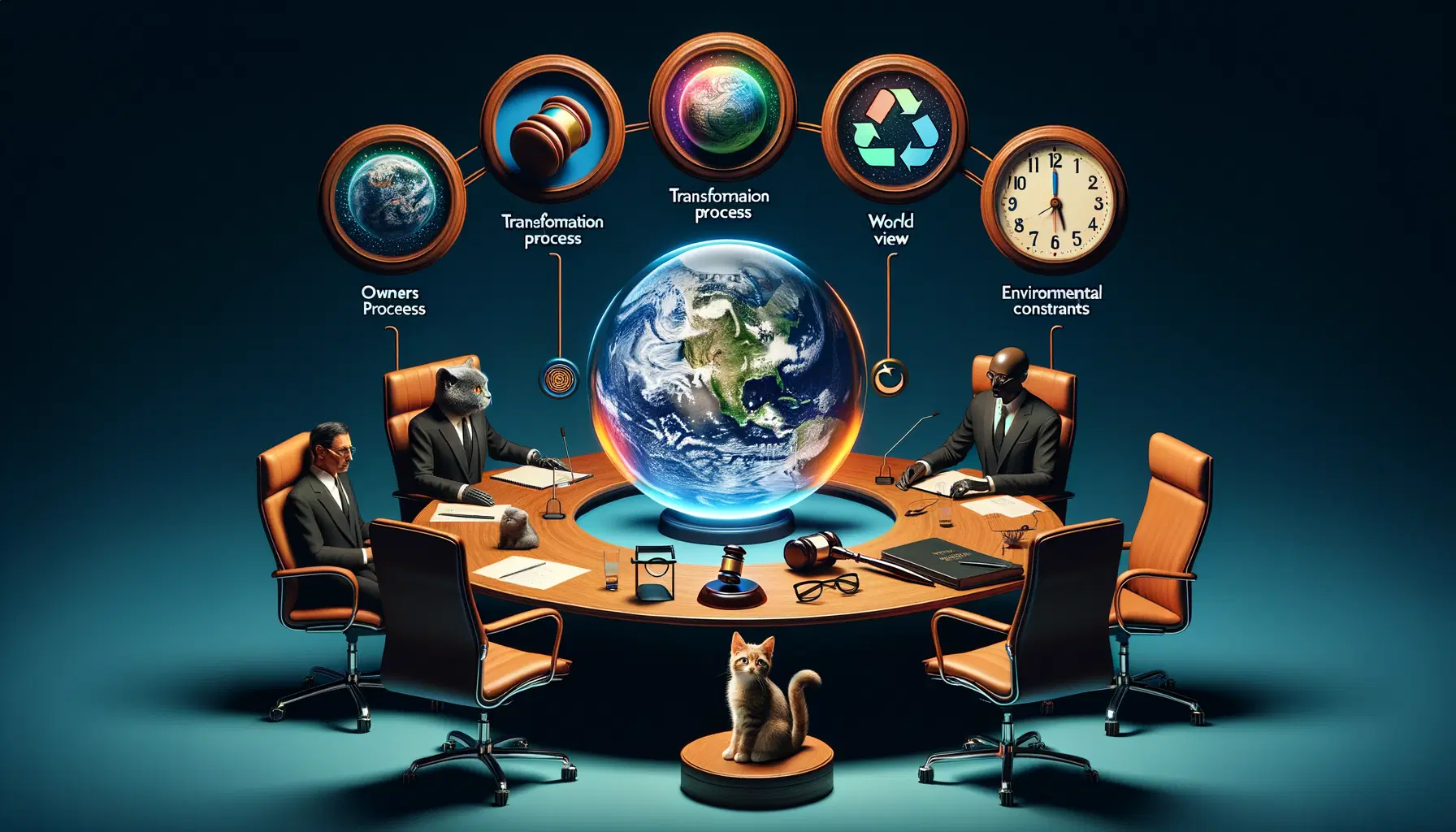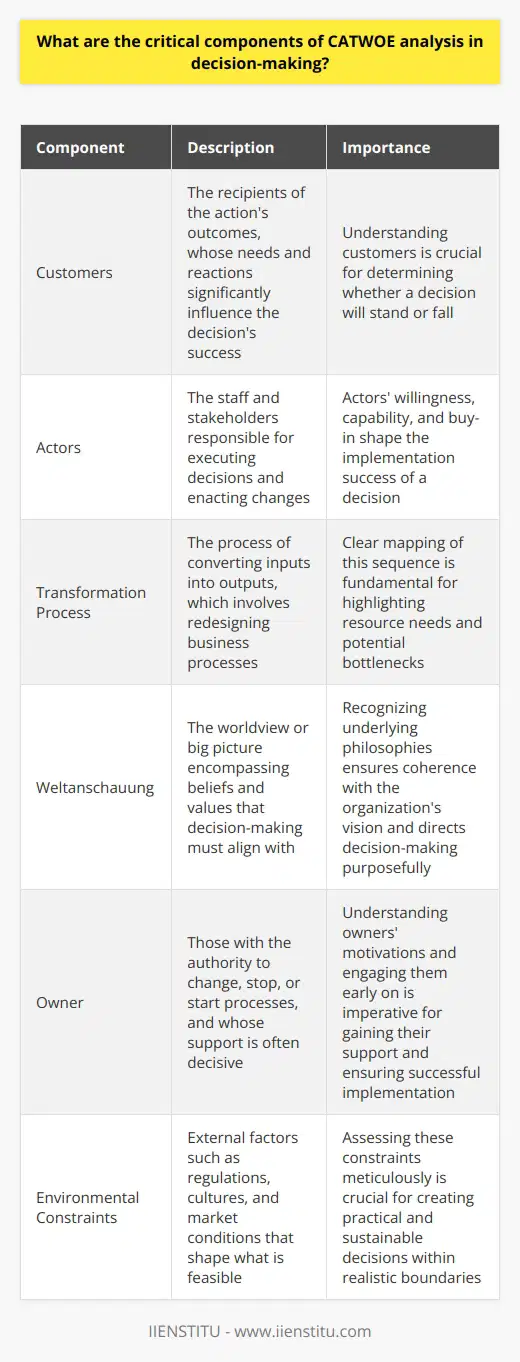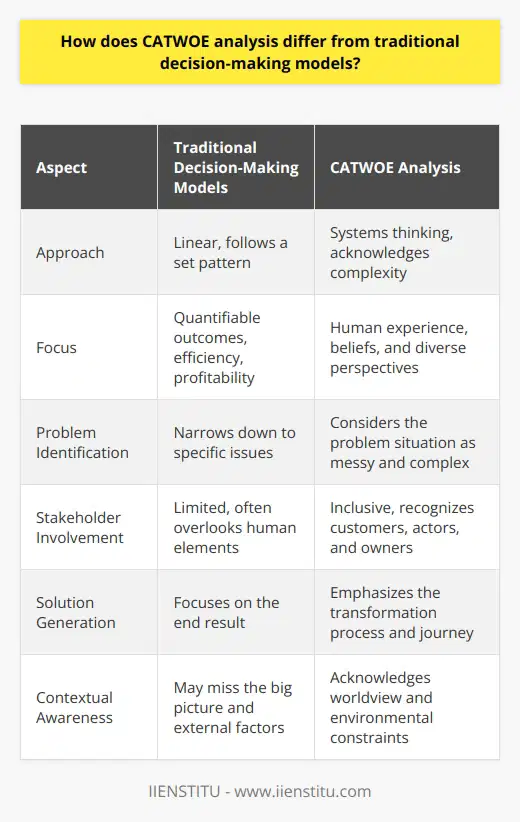
In the complex web of modern management and business operations, decision-making emerges as a pivotal skill that has profound implications on success and sustainability. Amidst the vast array of problem-solving frameworks, CATWOE Analysis provides a robust mechanism that aids managers, leaders, and decision-makers in dissecting issues systematically to arrive at well-grounded resolutions. This particular analysis serves as an apparatus to navigate through multifaceted business problems by dissecting them into manageable components, thereby enhancing clarity and perspective.
This academic piece delves deep into the realm of CATWOE Analysis, elucidating its core principles and practical applications. We aim to furnish our readers, whether enthusiastic learners or seasoned professionals enrolled in a problem solving course free of jargons, with a comprehensive guide that underscores the nuances of effective decision-making through the lenses of CATWOE. The ensuing sections will present an insightful exploration of this powerful tool, advocating its use as an indispensable part of one's decision-making arsenal or an essential element in an online mba course curriculum.
Introduction to CATWOE Analysis
Definition and Origins of CATWOE Analysis
CATWOE Analysis, stemming from soft systems methodology, is a cognitive tool used to ensure that all relevant stakeholders and impacting factors are considered when making decisions. The acronym CATWOE encapsulates six elements that are integral to this analysis: Customers, Actors, Transformation Process, Worldview, Owner, and Environmental Constraints. Each component is crucial in shaping the overall perspective and approach towards problem-solving.
The inception of CATWOE Analysis can be traced back to systems thinking and the work of Peter Checkland in the 1960s. As a response to the limitations of hard systems theory in dealing with the intricacies of human-oriented systems, Checkland unveiled the soft systems methodology, within which the CATWOE Analysis found its place as a structured, yet flexible approach to managing real-world complexities.
Importance of CATWOE in Decision-Making
CATWOE Analysis functions as a strategic lever in the decision-making process by ensuring a comprehensive evaluation of the situation at hand. It urges managers to contemplate beyond superficial solutions and to consider the ripple effects of their decisions across the various components of a system. In doing so, it actively contributes to the enrichment of problem-solving standards and fortifies organizational strategies.
Implementing CATWOE Analysis is especially crucial for businesses today, as it can unravel perspectives that might otherwise be obscured. This is particularly valuable in a highly competitive market where a single misstep can result in loss of customers, resources, or market positioning.
Objectives of the Blog
The primary goal of this blog is to acquaint readers with a clear understanding of CATWOE Analysis and its applications. By providing a detailed breakdown of each element within CATWOE, readers can grasp the essentials of this decision-making guide and learn to effectively integrate it into their problem-resolution practices.
Moreover, this blog strives to serve as a torchbearer for individuals and organizations keen on refining and sophisticating their decision-making measures. By the end of this piece, readers should be poised to adopt CATWOE Analysis as a standard lens through which complex dilemmas can be simplified and resolved with precision.
Understanding the Components of CATWOE Analysis
Customers: Identifying Stakeholders
In CATWOE Analysis, 'Customers' are defined as the beneficiaries or victims of a decision or change. These individuals or groups may directly or indirectly experience the impacts of the outcomes. Recognizing who the customers are is imperative; it ensures that their needs and expectations are met, which is fundamental to achieving sustainable success in any commercial endeavor.
Indeed, understanding stakeholder needs does not merely qualify as good practice; it is an indispensable component of sound management. Stakeholders can offer insights and highlight issues that decision-makers might miss, making their inclusion non-negotiable in the CATWOE framework.
Actors: The Players Involved
Actors are those individuals or entities who are integral in executing a decision or a transformation within an organization. These are the personnel who carry out actions and enforce decisions, making their cooperation and alignment with the company's vision essential.
Their role is not merely passive; actors influence the pace, direction, and effectiveness of the implementation of decisions. Therefore, acknowledging their capabilities, motivations, and limitations becomes critical when employing the CATWOE Analysis for resolving business issues.
Transformation Process: The Change Envisioned
The 'Transformation' element of CATWOE refers to the actual process by which inputs (such as resources or efforts) are converted into outputs (the results or changes). Understanding what the transformation involves is key to aligning organizational actions with desirable outcomes.
In the context of the problem-solving process, transformation defines the 'what' and 'how' of the change strategy. It necessitates a clear vision that is feasible and aligned with the broad goals of the enterprise.
Worldview: The Big Picture
'Worldview', sometimes referred to as Weltanschauung, encompasses the overall perspective or the set of beliefs and values that dictate how a situation is perceived. This mentality shapes the context within which solutions are sought and decisions are validated.
Influencing the formulation of strategy and objectives, the worldview contributes to the establishment of a coherent and purposeful decision-making environment. It serves as a guiding star steering the problem-solving process towards outcomes that are considered valuable and worthwhile.
Owner: The Decision-Maker
The 'Owner' is the individual or group that possesses the authority to effect change within the system. Having the 'ownership' of the problem-solving or decision-making process, these stakeholders have the power to initiate or terminate an action.
Acknowledging who the owner is within the CATWOE framework brings to prominence issues of accountability and responsibility. Recognizing their influence helps in outlining a process where decision-making is transparent and vested in the right hands.
Environmental Constraints: Recognizing Limitations
Environmental Constraints are those external conditions that limit or shape the decision-making options. These constraints can include regulations, economic conditions, technological advancements, societal expectations, and ethical norms.
Awareness of these constraints is central to conducting a realistic CATWOE Analysis. It ensures decision-makers are prepared for possible obstacles and are devising strategies within the ambit of these limitations, avoiding unforeseen complications.
Applying CATWOE Analysis for Effective Decision-Making
Step-by-Step Guide to Implementing CATWOE
To efficiently implement CATWOE Analysis, gathering comprehensive data on each of its components is essential. This initial step involves engaging with stakeholders to understand the potential effects of decisions and foster participation across levels.
Next, mapping out the relationships between the CATWOE elements offers a visual representation of the dynamics at play. It helps in identifying the interconnections and dependencies that may influence decision-making and problem-solving processes.
Real-world Examples of CATWOE in Action
Through numerous case studies, the effectiveness of CATWOE Analysis in real-world scenarios becomes apparent. For instance, companies that have faced complex market-entry decisions have utilized CATWOE to break down the various aspects of their strategies and assess the implications for each stakeholder group.
Analyzing the positive outcomes generated through meticulous CATWOE application provides tangible proof of its utility. It highlights how a structured approach to decision-making can lead to successful problem resolution, strategic planning, and resource optimization.
Factors that Enhance CATWOE Efficacy
Two significant factors that amplify the effectiveness of CATWOE Analysis are effective communication and flexibility. Ensuring all stakeholders have a platform to voice their perspective and concerns can engender a comprehensive understanding of the issue at hand.
Additionally, maintaining flexibility and openness during the analysis phase can lead to the discovery of creative solutions and adaptive strategies that uphold the interests of all parties involved.
Common Pitfalls and How to Avoid Them
One common pitfall in employing CATWOE Analysis is the misidentification of elements, which can lead to inadequate solutions or further complication of the problem. To avert this, a meticulous examination of each component must be upheld throughout the analysis.
Equally, overlooking environmental constraints can render decisions ineffectual or noncompliant. Acknowledging the broader context within which decisions are made, and ensuring alignment with external factors, is crucial for the success of the CATWOE approach.
Recapitulation of Key Points
CATWOE Analysis offers a comprehensive and philosophical framework that promotes holistic and effective decision-making practices. By evaluating all facets of a situation, including the intricate web of stakeholders and influencers, organizations can formulate decisions that are not only strategic but also sustainable and aligned with their core values.
The essence of CATWOE underpins its role in cultivating a deeper understanding of business problems and in steering managers towards informed and reasoned solutions.
Final Reflections
The potential impact of CATWOE Analysis on business outcomes cannot be overstated. Its application ushers in a pronounced degree of conscientiousness into the decision-making realm, posing significant advantages for those who aim to navigate through business intricacies adeptly.
Understanding and employing CATWOE promises to elevate the standard of problem-solving, engendering a culture of strategic thinking and intelligent management.
Leaders, managers, and decision-makers are encouraged to engage with CATWOE Analysis in real scenarios to fully grasp its advantages. It's an invitation to augment one's arsenal of management techniques with a potent and versatile tool.
For further development, one might consider enrolling in visual aids, interactive problem-solving courses, or comprehensive management and decision-making guides. Seamless integration of CATWOE into daily practices might just be the revolutionary step towards achieving unparalleled organizational success.
Frequently Asked Questions
What are the critical components of CATWOE analysis in decision-making?
Understanding CATWOE Analysis
Decision-making in complex environments often necessitates a structured approach. CATWOE analysis represents one such systematic method. It helps in understanding business processes and decision-making impacts. Its components are crucial. Each plays a distinct role in the analysis. They interact to provide deep insights.
The 'C' for Customers
Customers form the analysis's core. They are the recipients of the action's outcomes. Their needs and reactions weigh significantly. Understanding them is crucial. It informs whether a decision stands or falls.
The 'A' for Actors
Actors enact the changes. They are the staff and stakeholders executing decisions. Their willingness and capability are vital. Their buy-in shapes the implementation success. Comprehend their perspectives for effective solutions.
The 'T' for Transformation Process
Every decision instigates transformation. The process involves converting inputs into outputs. Business processes get redesigned here. Clear mapping of this sequence is fundamental. It highlights resource needs and potential bottlenecks.
The 'W' for Weltanschauung
Weltanschauung implies the worldview. It's the big picture encompassing beliefs and values. Decision-making must align with this. It ensures coherence with the organization's vision. Recognize underlying philosophies. They direct decision-making purposefully.
The 'O' for Owner
Owners possess the authority to change. They can stop or start processes. Understanding their motivations is imperative. They have vested interests. Their support is often decisive. Engage them early on.
The 'E' for Environmental Constraints
Every decision faces external constraints. These include regulations, cultures, and market conditions. They shape what is feasible. Ignoring them invites failure. Assess these constraints meticulously. They dictate practical boundaries.
Integration in Decision-Making
CATWOE forms the bedrock of sound analysis. Each component informs the decision-making process. They ensure comprehensive understanding. This approach mitigates risks. It aids in creating sustainable decisions.
Utilize CATWOE as a holistic tool. It brings clarity. It drives coherent strategies. It aligns actions with broader goals. Incorporate it for structured, strategic thinking. Decision-making excellence often follows.

How does CATWOE analysis differ from traditional decision-making models?
Understanding CATWOE Analysis
CATWOE stands out in the world of decision-making methodologies. Unlike conventional models, it offers a unique framework. It delves deep into complex issues. This complexity often stymies traditional approaches.
Traditional Decision-Making Models
Traditional decision-making methods tend to be more linear. They often follow a set pattern. First, they identify the problem. Then, they generate solutions. After that, they evaluate alternatives. Finally, they implement the chosen solution.
These standard methods focus on quantifiable outcomes. They aim for efficiency and profitability. They stress tangible results. They consider less the human element. The subjective aspects get less attention.
CATWOE Brings a Different Perspective
CATWOE analysis emerges from Soft Systems Methodology (SSM). Peter Checkland developed it. It takes a systems thinking approach. Here, problem situations are messy and complex. They call for an understanding of different worldviews.
Components of CATWOE
CATWOE comprises six elements:
- Customers: Who benefits or suffers from the process?
- Actors: Who are the stakeholders involved?
- Transformation process: What changes are occurring?
- Worldview: What is the big picture?
- Owner: Who owns the process being analyzed?
- Environmental constraints: What are the limitations?
Each component plays a critical role. It contributes to a holistic understanding.
CATWOE Versus Traditional Models
CATWOE invites broader exploration. It goes beyond quantifiable factors. It considers human experience and beliefs. It embodies a multi-perspective approach. This stands in contrast to conventional models. They often overlook these aspects.
Customers and Actors bring the human element into focus. Traditional methods do not always recognize these individuals. CATWOE says their perspectives matter.
The Transformation process spans more than just the outcome. It considers the journey itself. Traditional models fixate on the end result.
Worldview acknowledges the overarching narrative. Traditional methods might miss this. They can be too focused on specifics.
Owner shifts the spotlight to responsibility and power. This depth of analysis is rare in traditional models. They prefer a narrower view.
Environmental Constraints highlight external factors. Old-fashioned methods can ignore such constraints. They favor internal control and predictability.
CATWOE as a Richer Tool for Decision-Making
CATWOE sets itself apart as a richer, more nuanced tool. It caters to the interconnectedness of modern issues. It appreciates the human condition. It respects societal values. Traditional methods might struggle with such complexity.
CATWOE fosters dialogue and understanding. It welcomes diverse viewpoints. It identifies ethical considerations. It recognizes the non-linear nature of human systems.
Embracing Complexity and Subjectivity
CATWOE endorses complexity. It embraces subjectivity. In it, every stakeholder has a voice. The analysis becomes more democratic. It allows for a range of solutions. These solutions may be more sustainable and ethical.
In conclusion, CATWOE analysis markedly differs from traditional decision-making models. It highlights the need for a multifaceted approach. It suggests that understanding humans is as important as understanding processes. Traditional methods might find this revolutionary. But, perhaps that is exactly what our complex world needs.

Can you highlight any practical applications of CATWOE analysis in organizational contexts?
Understanding CATWOE Analysis
Before diving into its practical applications, let’s first understand what CATWOE analysis is. CATWOE stands for Customers, Actors, Transformation process, Worldview, Owner, and Environmental constraints. It's a robust tool used in systems thinking and problem-solving within the organizational context. Employing CATWOE helps dissect complex issues by considering all stakeholders involved.
Practical Applications in Organizations
Strategic Planning
Strategic planning requires holistic insights. CATWOE guides this process. It ensures planners consider the wide impacts of their strategies. Teams can anticipate reactions from different stakeholders. They can thus tailor plans to address varied needs.
Change Management
Change in any organization evokes varied responses. CATWOE helps identify these responses. It informs the change strategies accordingly. Teams understand potential bottlenecks before they appear. Consequently, they create more robust change management plans.
Process Improvement
Improving internal processes can be fraught with challenges. CATWOE offers a systematic approach. It considers each element of a process. This enables a thorough analysis. Organizations can optimize operations while mitigating risks.
Conflict Resolution
Conflicts often arise from misaligned interests. CATWOE explores different perspectives. It provides a framework for balanced solutions. Key issues become apparent. Thus, organizations can find common ground more easily.
Policy Development
Policies shape organizational behavior. To develop effective policies, CATWOE is crucial. It probes underlying motives and consequences. This ensures policies align with the broader organizational worldview.
Innovation and Product Development
Creating a new product involves many moving parts. CATWOE breaks down these components. It helps teams consider the full product lifecycle. They can then innovate with customer and environmental constraints in mind.
Marketing Strategies
Successful marketing relies on deep customer understanding. CATWOE analysis brings customer aspects to the fore. Marketers can design campaigns that resonate deeply. They also foresee and address potential conflicts of interest.
Benefits of Applying CATWOE in Organizations
Ensure holistic problem-solving
Align strategies with stakeholder needs
Streamline change management
Facilitate process optimization
Enhance conflict resolution
Inform policy making with a full perspective
Support sustainable innovation
Develop customer-centric marketing strategies
CATWOE proves its worth across multiple aspects of organizational function. It transforms complex, multifaceted problems into manageable components. Leaders and managers can thus make informed, strategic decisions. The practical applications above showcase CATWOE's versatility and its potential to pioneer effective solutions in various organizational scenarios.



